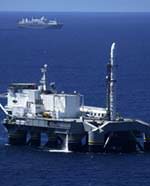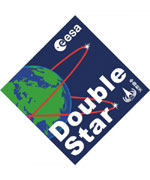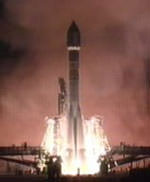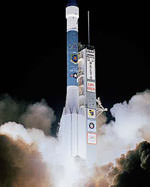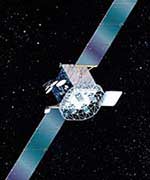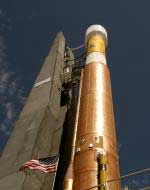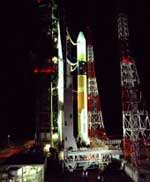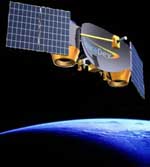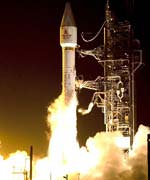
Image credit: ILS
International Launch Services (ILS) scored another success tonight, with the launch of the AMC-10 satellite on board a Lockheed Martin-built Atlas IIAS rocket.
The rocket lifted off at 6:46 p.m. from Cape Canaveral?s Space Launch Complex 36A, and placed the satellite into a transfer orbit 28 minutes later. The satellite is an A2100 model, built by Lockheed Martin for SES AMERICOM of Princeton, N.J. This was the first launch of the year for ILS. It also is one of four missions for SES AMERICOM on the ILS manifest this year.
?We are gratified and honored that such a prominent satellite operator as SES AMERICOM has signaled such confidence in our team,? said ILS President Mark Albrecht. ?Since the AMC-10 and AMC-11 satellites are two of a kind, we fully expect to be repeating another successful mission right here at the Cape in a few months? time.?
Albrecht noted the long-standing relationship with ILS and SES AMERICOM, and its parent company, SES GLOBAL. To date ILS has launched 15 satellites for companies affiliated with SES GLOBAL, including six for the SES AMERICOM fleet. ?With the SES family as the world?s largest satellite operator, it is no secret that we relish the fact that ILS is its largest launch services provider. We?re pleased to be welcoming them back again this year to both our launch sites ? at the Cape and in Kazakhstan ? for SES AMERICOM missions this year,? Albrecht said. Two SES AMERICOM satellites ? AMC-12 and AMC-15 ? are set to launch on Proton vehicles in 2004.
ILS is a joint venture of Lockheed Martin (NYSE:LMT) and Russian rocket builder Khrunichev State Research and Production Space Center. ILS markets and manages the missions on the Atlas rocket in the United States and on the Proton rocket at the Baikonur Cosmodrome, Kazakhstan. ILS was formed in 1995, and is based in McLean, Va., a suburb of Washington, D.C.
Dean Olmstead, president and CEO of SES AMERICOM, said: “The AMC-10 mission enables us to continue delivering the highest quality distribution services to the top-tier cable programmers who entrust us with more channels and their new high-definition services; in turn we have entrusted this satellite to ILS and its terrifically reliable Atlas IIAS launch vehicle. Our hope is that the AMC-11 launch planned for May will proceed just as flawlessly as tonight’s AMC-10 launch.”
Tonight?s rocket was the 27th flown in the Atlas IIAS configuration. Three more Atlas IIAS vehicles are scheduled to launch this year before the model is retired. ILS also has customers scheduled on Atlas III and Atlas V vehicles this year. The Atlas II, III and V series have achieved 100 percent success through 69 consecutive launches. The Atlas IIAS can lift 8,200 pounds to geosynchronous transfer orbit. The Atlas III can lift up to 9,920 pounds, and the current -production Atlas V is available in a range of configurations to lift payloads up to 19,000 pounds.
The Atlas rockets and their Centaur upper stages are built by Lockheed Martin Space Systems Company in Denver, Colo.; Harlingen, Texas; and San Diego, Calif. The A2100 satellite is built by Lockheed Martin Commercial Space Systems in New Town, Pa., and Sunnyvale, Calif.
Original Source: ILS News Release

